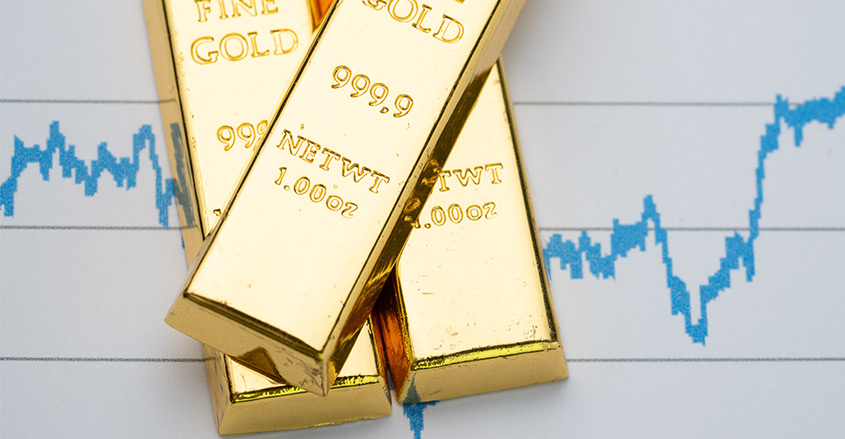Warren Buffett, the famed billionaire investor, has changed his thinking on gold and invested in the yellow commodity. Rather, that’s what the media headlines would have you believe.
What is true: During the second quarter, at height of the coronavirus panic, Buffett’s Berkshire Hathaway unloaded many of its bank stock holdings and bought shares of a gold mining stock — Barrick Gold Corp. (GOLD).
This sparked confusion by many Buffett-followers, including media outlets, as Buffett has notoriously questioned the usefulness of gold. This includes the famous 1998 quote from a Harvard speech, where Buffett said, “[Gold] gets dug out of the ground in Africa, or someplace. Then we melt it down, dig another hole, bury it again and pay people to stand around guarding it. It has no utility. Anyone watching from Mars would be scratching their head.”
Buffett’s gold move, explained
Buffett’s Berkshire Hathaway invested $564 million in Barrick Gold Corp. (GOLD) — a Canadian gold mining company with gold and copper mines in 13 countries.
What one can infer is that Buffett believes the U.S. might need many more months or years to fully recover from the pandemic fallout. Buffett’s Berkshire sold off shares of Wells Fargo (WFC) — a stock he’s owned since 1962 — and is no longer the bank’s largest shareholder. Berkshire also unloaded shares of JPMorgan Chase (JPM), Goldman Sachs (GS), Bank of New York Mellon (BK) and PNC Financial (PNC).
Months ago, when the coronavirus was hitting full swing, in May, Buffett warned that stock prices could be volatile for an unknown period of time. Volatility and uncertainty are good for gold prices.
Gold is a fear gauge
The price of gold rises when there’s a lot of uncertainty in the market. However, it’s also an inflation hedge. Gold rises when the Federal Reserve injects money into the economy, which brings fears of inflation.
Thus, amid the coronavirus pandemic, it’s no surprise the price of gold is up 27% in 2020, compared to the 6% return of the S&P 500.

But Buffett isn’t wrong about gold. While gold is an asset that does well amid uncertainty, but it’s actual utility or usefulness is limited.
Berkshire now owns a small portion of a gold mining company. Buffett’s investing conglomerate invested a small fraction of its funds (over $200 billion) in a single Canadian mining company.
To Buffett, gold still has no utility. It’s useless and provides no rate of return for the most part. However, a company like Barrick Gold is mining company. It digs gold out of the ground and sells it.
More importantly, what’s appealing to Buffett and his investing lieutenants — who increasingly run the Berkshire businesses — is that Barrick pays dividends.
With that, Barrick Gold provides investors with some utility; it’s not just a commodity. The gold miner is paying an $0.08 per share dividend and has increased its annual dividend in each of the last three years. Granted, its dividend yield is just 1.1%.
Gold is great diversification
A small stake in a gold stock is a hedge against another resurgence in the coronavirus or hiccup in the economic recovery, which could force quantitative easing by the government. Think of Buffett’s gold miner investment as a cheap form of catastrophe insurance.
Many gold mining stocks will do well if gold prices rise and gold has been the second-best performing asset of 2020, behind only Bitcoin.
Part of the thing with gold is that it needs more uncertainty to drive prices higher. But the government has done a very good job of funnelling money into the economy and keeping unemployment in relative check. Thus, as individuals adjust to the new normal and the economic recovery continues, gold likely won’t do so well.
I’d expect Buffett to keep his small stake in Barrick relatively stable and don’t expect Barrick or other miners to become a large part of his portfolio anytime soon. Gold, whether it be miners or an ETF that tracks the commodity, moves independently of many asset classes, however, which makes it useful for diversification purposes.
A small stake in a gold mining stock or broad, exchange-traded fund (ETF) such as the SPDR Gold Shares (GLD) would be useful in adding diversification. Alternatively, there are companies that have no mining operations but still do well when gold does. For instance, Franco-Nevada Corporation (FNV) is a Canada-based company that owns gold mining royalty streams.
But, again, the amount invested in gold doesn’t have to be anything more than a couple percent of an entire portfolio. For context, Berkshire’s Barrick Gold stake is 0.3% of its portfolio.


